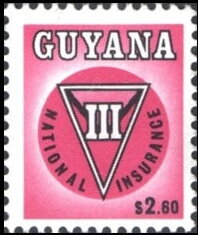Stamp: National flag in circle (Guyana 1969)
National flag in circle (Guyana 1969)
01 January (Guyana ) within release National Insurance goes into circulation Stamp National flag in circle face value 2.60 Guyanese dollar
| Stamp National flag in circle in catalogues | |
|---|---|
| Colnect codes: | Col: GY NI1969-04 |
Stamp is square format.
Class III Revenue Reverend cat. no: N4Also in the issue National Insurance:
- Stamp - National flag in circle face value 50;
- Stamp - National flag in circle face value 1.15;
- Stamp - National flag in circle face value 1.90;
- Stamp - National flag in circle face value 2.60;
- Stamp - National flag in circle face value 3.40;
- Stamp - National flag in circle face value 4.10;
|
Data entry completed
56%
|
|
|---|---|
| Stamp National flag in circle in digits | |
| Country: | Guyana |
| Date: | 1969-01-01 |
| Perforation: | 14½ |
| Emission: | Revenue |
| Format: | Stamp |
| Face Value: | 2.60 Guyanese dollar |
| Print run: | 600000 |
Stamp National flag in circle it reflects the thematic directions:
A flag is a piece of fabric (most often rectangular or quadrilateral) with a distinctive design that is used as a symbol, as a signaling device, or as decoration. The term flag is also used to refer to the graphic design employed, and flags have since evolved into a general tool for rudimentary signalling and identification, especially in environments where communication is similarly challenging (such as the maritime environment where semaphore is used). National flags are patriotic symbols with varied wide-ranging interpretations, often including strong military associations due to their original and ongoing military uses. Flags are also used in messaging, advertising, or for other decorative purposes. The study of flags is known as vexillology, from the Latin word vexillum, meaning flag or banner.
A number is a mathematical object used to count, measure, and label. The most basic examples are the natural numbers 1, 2, 3, 4, and so forth. Numbers can be represented in language with number words. More universally, individual numbers can be represented by symbols, called numerals; for example, "5" is a numeral that represents the number five. As only a relatively small number of symbols can be memorized, basic numerals are commonly organized in a numeral system, which is an organized way to represent any number. The most common numeral system is the Hindu–Arabic numeral system, which allows for the representation of any non-negative integer using a combination of ten fundamental numeric symbols, called digits. In addition to their use in counting and measuring, numerals are often used for labels (as with telephone numbers), for ordering (as with serial numbers), and for codes (as with ISBNs). In common usage, a numeral is not clearly distinguished from the number that it represents.


